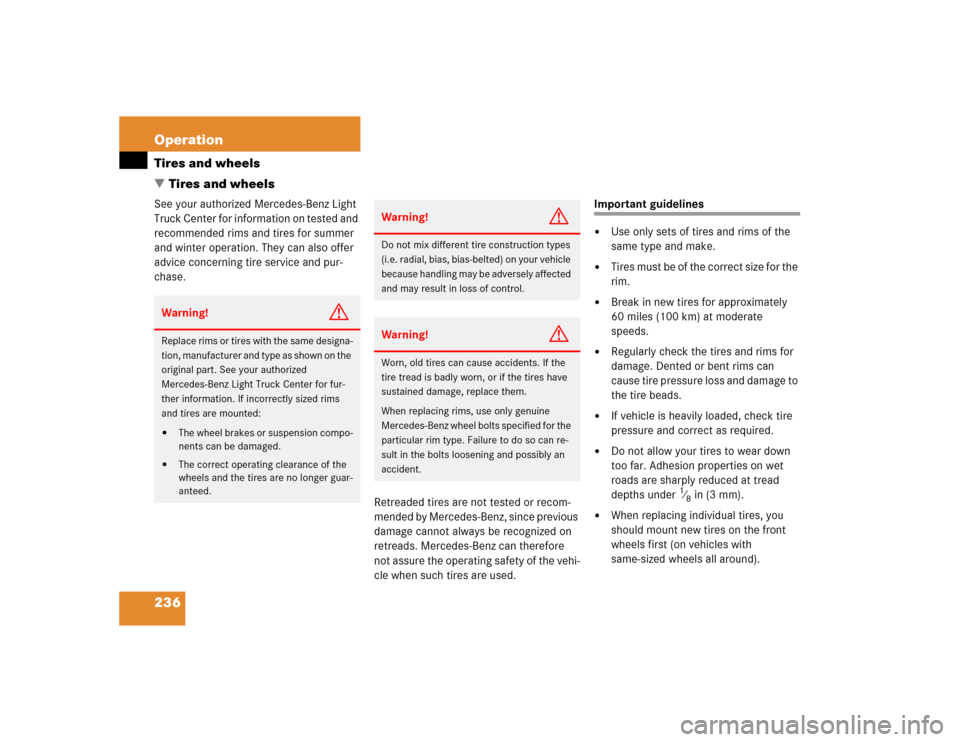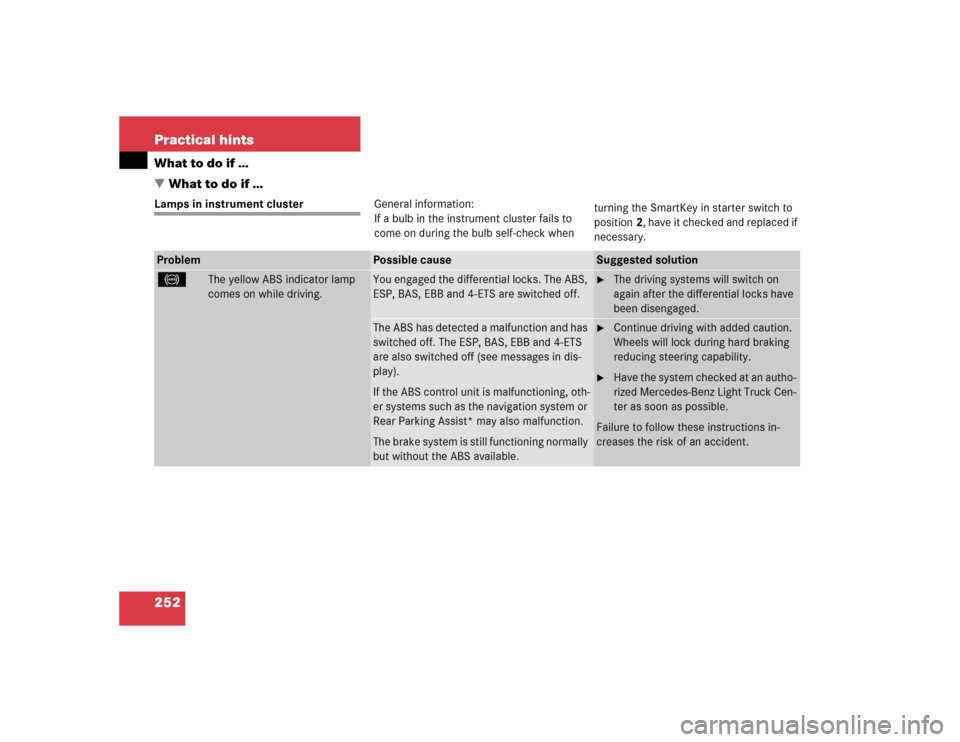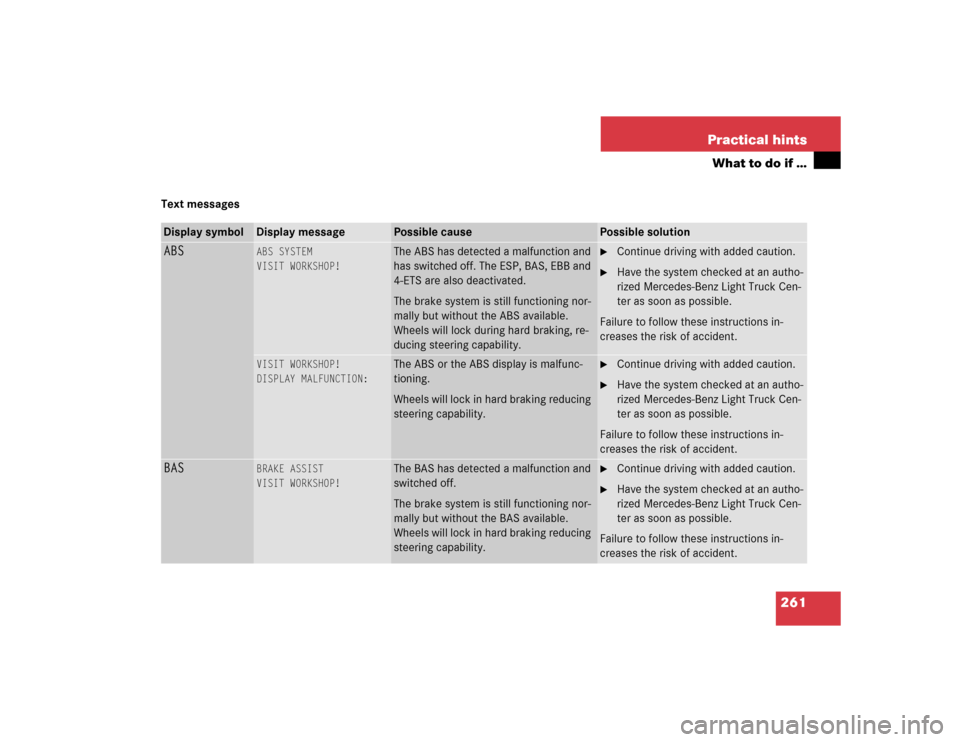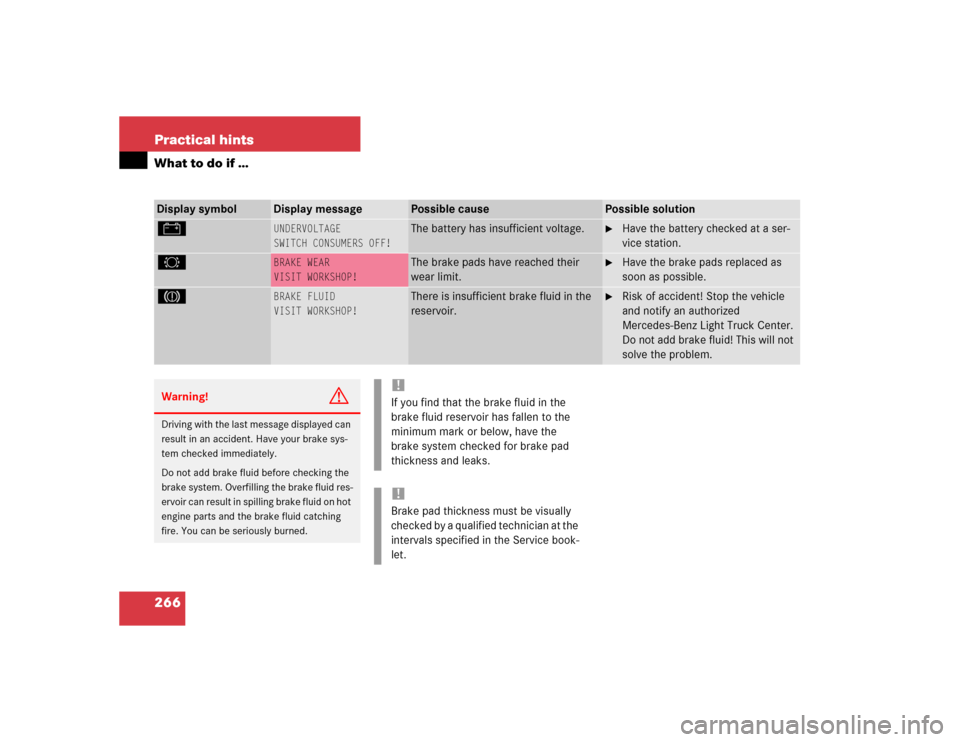Page 236 of 376

236 OperationTires and wheels
�Tires and wheelsSee your authorized Mercedes-Benz Light
Truck Center for information on tested and
recommended rims and tires for summer
and winter operation. They can also offer
advice concerning tire service and pur-
chase.
Retreaded tires are not tested or recom-
mended by Mercedes-Benz, since previous
damage cannot always be recognized on
retreads. Mercedes-Benz can therefore
not assure the operating safety of the vehi-
cle when such tires are used.
Important guidelines�
Use only sets of tires and rims of the
same type and make.
�
Tires must be of the correct size for the
rim.
�
Break in new tires for approximately
60 miles (100 km) at moderate
speeds.
�
Regularly check the tires and rims for
damage. Dented or bent rims can
cause tire pressure loss and damage to
the tire beads.
�
If vehicle is heavily loaded, check tire
pressure and correct as required.
�
Do not allow your tires to wear down
too far. Adhesion properties on wet
roads are sharply reduced at tread
depths under
1⁄8in (3 mm).
�
When replacing individual tires, you
should mount new tires on the front
wheels first (on vehicles with
same-sized wheels all around).
Warning!
G
Replace rims or tires with the same designa-
tion, manufacturer and type as shown on the
original part. See your authorized
Mercedes-Benz Light Truck Center for fur-
ther information. If incorrectly sized rims
and tires are mounted:�
The wheel brakes or suspension compo-
nents can be damaged.
�
The correct operating clearance of the
wheels and the tires are no longer guar-
anteed.
Warning!
G
Do not mix different tire construction types
(i.e. radial, bias, bias-belted) on your vehicle
because handling may be adversely affected
and may result in loss of control.Warning!
G
Worn, old tires can cause accidents. If the
tire tread is badly worn, or if the tires have
sustained damage, replace them.
When replacing rims, use only genuine
Mercedes-Benz wheel bolts specified for the
particular rim type. Failure to do so can re-
sult in the bolts loosening and possibly an
accident.
Page 244 of 376

244 OperationVehicle care
�Vehicle careCleaning and care of the vehicle
While in operation, even while parked, your
vehicle is subjected to varying external in-
fluences which, if gone unchecked, can at-
tack the paintwork as well as the
underbody and cause lasting damage.Such damage is caused not only by ex-
treme and varying climatic conditions, but
also by:
�
Air pollution
�
Road salt
�
Tar
�
Gravel and stone chipping
To avoid paint damage, you should imme-
diately remove:
�
Grease and oil
�
Fuel
�
Coolant
�
Brake fluid
�
Bird droppings
�
Insects
�
Tree resins, etc.
Frequent washing reduces and/or elimi-
nates the aggressiveness and potency of
the above adverse influences.More frequent washings are necessary to
deal with unfavorable conditions:
�
Near the ocean
�
In industrial areas (smoke, exhaust
emissions)
�
During winter operation
You should check your vehicle from time to
time for stone chipping or other damage.
A n y d a m a g e s h o u l d b e r e p a i r e d a s s o o n a s
possible to prevent corrosion.
In doing so, do not neglect the underbody
of the vehicle. A prerequisite for a thor-
ough check is a washing of the underbody
followed by a thorough inspection. Dam-
aged areas need to be re-undercoated.
Your vehicle has been treated at the facto-
ry with a wax-base rustproofing in the body
cavities which will last for the lifetime of
the vehicle. Post-production treatment is
neither necessary nor recommended by
Mercedes-Benz because of the possibility
of incompatibility between materials used
in the production process and others ap-
plied later.
Warning!
G
Many cleaning products can be hazardous.
Some are poisonous, others are flammable.
Always follow the instructions on the partic-
ular container. Always open your vehicle’s
doors or windows when cleaning the inside.
Never use fluids or solvents that are not de-
signed for cleaning your vehicle.
Page 252 of 376

252 Practical hintsWhat to do if …
�What to do if …Lamps in instrument clusterGeneral information:
If a bulb in the instrument cluster fails to
come on during the bulb self-check when turning the SmartKey in starter switch to
position2, have it checked and replaced if
necessary.Problem
Possible cause
Suggested solution
-
The yellow ABS indicator lamp
comes on while driving.
You engaged the differential locks. The ABS,
ESP, BAS, EBB and 4-ETS are switched off.
�
The driving systems will switch on
again after the differential locks have
been disengaged.
The ABS has detected a malfunction and has
switched off. The ESP, BAS, EBB and 4-ETS
are also switched off (see messages in dis-
play).
If the ABS control unit is malfunctioning, oth-
er systems such as the navigation system or
Rear Parking Assist* may also malfunction.
The brake system is still functioning normally
but without the ABS available.
�
Continue driving with added caution.
Wheels will lock during hard braking
reducing steering capability.
�
Have the system checked at an autho-
rized Mercedes-Benz Light Truck Cen-
ter as soon as possible.
Failure to follow these instructions in-
creases the risk of an accident.
Page 254 of 376

254 Practical hintsWhat to do if …Problem
Possible cause
Suggested solution
;
(USA only)
3
(Canada only)The red brake warning lamp
comes on while driving and you
hear a warning sound.
You are driving with the parking brake set.
�
Release the parking brake
(�page 44).
�
Also note the messages in the multi-
function display (
�page 260).
The red brake warning lamp
comes on while driving.
There is insufficient brake fluid in the reser-
voir.
�
Risk of accident! Carefully stop the
vehicle and notify an authorized
Mercedes-Benz Light Truck Center.
Do not add brake fluid! This will not
solve the problem.
�
Also note the messages in the multi-
function display (
�page 260).
Warning!
G
Driving with the brake warning lamp illumi-
nated can result in an accident. Have your
brake system checked immediately if the
brake warning lap stays on.
Do not add brake fluid before checking the
brake system. Overfilling the brake fluid res-
ervoir can result in spilling brake fluid on hot
engine parts and the brake fluid catching
fire. You could be seriously burned.
!If you find that the brake fluid in the
brake fluid reservoir has fallen to the
minimum mark or below, have the
brake system checked for brake pad
thickness and leaks.
Page 255 of 376
255 Practical hints
What to do if …
Problem
Possible cause
Suggested solution
;
(USA only)
3
(Canada only)
-
The red brake warning lamp and
the yellow ABS indicator lamp
come on when the engine is run-
ning and you hear a warning
sound for approximately five sec-
onds.
The EBB has detected a malfunction and has
switched off. You should be prepared for your
vehicle to perform differently than normal
when braking.
�
Continue driving with added caution.
�
Have the system checked at an autho-
rized Mercedes-Benz Light Truck Cen-
ter as soon as possible.
�
Also note the messages in the multi-
function display (
�page 260).
Failure to follow these instructions in-
creases the risk of accidents.
Page 261 of 376

261 Practical hints
What to do if …
Text messagesDisplay symbol
Display message
Possible cause
Possible solution
ABS
ABS SYSTEM
VISIT WORKSHOP!
The ABS has detected a malfunction and
has switched off. The ESP, BAS, EBB and
4-ETS are also deactivated.
The brake system is still functioning nor-
mally but without the ABS available.
Wheels will lock during hard braking, re-
ducing steering capability.
�
Continue driving with added caution.
�
Have the system checked at an autho-
rized Mercedes-Benz Light Truck Cen-
ter as soon as possible.
Failure to follow these instructions in-
creases the risk of accident.
VISIT WORKSHOP!
DISPLAY MALFUNCTION:
The ABS or the ABS display is malfunc-
tioning.
Wheels will lock in hard braking reducing
steering capability.
�
Continue driving with added caution.
�
Have the system checked at an autho-
rized Mercedes-Benz Light Truck Cen-
ter as soon as possible.
Failure to follow these instructions in-
creases the risk of accident.
BAS
BRAKE ASSIST
VISIT WORKSHOP!
The BAS has detected a malfunction and
switched off.
The brake system is still functioning nor-
mally but without the BAS available.
Wheels will lock in hard braking reducing
steering capability.
�
Continue driving with added caution.
�
Have the system checked at an autho-
rized Mercedes-Benz Light Truck Cen-
ter as soon as possible.
Failure to follow these instructions in-
creases the risk of accident.
Page 264 of 376
264 Practical hintsWhat to do if …Display
Display message
Possible cause
Possible solution
ESP
ESP
VISIT WORKSHOP!
The ESP is switched off due to a malfunc-
tion or an interruption in the power sup-
ply.
The brake system is still functioning nor-
mally but without ESP, ABS and BAS avail-
able.
If in addition the ABS is malfunctioning,
only partial engine output will be avail-
able.
�
Continue driving with added caution.
�
Have the system checked at an autho-
rized Mercedes-Benz Light Truck Cen-
ter as soon as possible.
Failure to follow these instructions in-
creases the risk of accident.
Page 266 of 376

266 Practical hintsWhat to do if …Display symbol
Display message
Possible cause
Possible solution
#
UNDERVOLTAGE
SWITCH CONSUMERS OFF!
The battery has insufficient voltage.
�
Have the battery checked at a ser-
vice station.
2
BRAKE WEAR
VISIT WORKSHOP!
The brake pads have reached their
wear limit.
�
Have the brake pads replaced as
soon as possible.
3
BRAKE FLUID
VISIT WORKSHOP!
There is insufficient brake fluid in the
reservoir.
�
Risk of accident! Stop the vehicle
and notify an authorized
Mercedes-Benz Light Truck Center.
Do not add brake fluid! This will not
solve the problem.
Warning!
G
Driving with the last message displayed can
result in an accident. Have your brake sys-
tem checked immediately.
Do not add brake fluid before checking the
brake system. Overfilling the brake fluid res-
ervoir can result in spilling brake fluid on hot
engine parts and the brake fluid catching
fire. You can be seriously burned.
!If you find that the brake fluid in the
brake fluid reservoir has fallen to the
minimum mark or below, have the
brake system checked for brake pad
thickness and leaks. !Brake pad thickness must be visually
checked by a qualified technician at the
intervals specified in the Service book-
let.